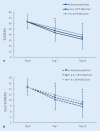[Probiotic baths for atopic dermatitis]
- PMID: 33730257
- PMCID: PMC8169505
- DOI: 10.1007/s00105-021-04789-2
[Probiotic baths for atopic dermatitis]
Abstract
Background: The importance of the skin microbiome in the pathogenesis of atopic dermatitis (AD) is gaining increasing attention in current research and offers opportunities for new innovative treatment options.
Objectives: This study investigated the efficacy of a probiotic bath additive on clinical symptoms and skin microbiome of patients with AD.
Materials and methods: The study was randomized and double-blind: 22 patients applied a 10-min partial bath with 4.5 × 109 or 9 × 109 colony-forming units (CFU) of viable lactic acid bacteria per liter daily over a period of 14 days. The clinical symptoms were documented using the SCORing Atopic Dermatitis (SCORAD) index and a patient questionnaire at day 0, day 7 and day 14. In addition, skin swabs were taken for subsequent nucleic acid extraction for quantitative Staphylococcus aureus polymerase chain reaction and microbiome analysis using amplicon sequencing.
Results: Comparable efficacy was documented in both treatment groups: Probiotic baths with a concentration of 4.5-9 × 109 CFU/liter led to a significant reduction in SCORAD scores (start of study: 63.04) and local SCORAD (14.68) on day 7 (SCORAD 47.09, local SCORAD 10.99) and day 14 (SCORAD 35.26, local SCORAD 8.54). Furthermore, the patient-assessed parameters skin dryness and itching improved significantly over the treatment period. At the same time, the mean gene copy number of S. aureus decreased by about 83% and microbiome analyses showed an increase in the richness of the bacterial community.
Conclusions: Topical application of a probiotic bath represents a promising supportive treatment option for AD that alleviates existing dysbiosis.
Zusammenfassung: HINTERGRUND: Die Bedeutung des epidermalen Mikrobioms bei der Pathogenese der atopischen Dermatitis (AD) rückt verstärkt in den Fokus aktueller Forschung.
Ziel der arbeit: Die Wirkung eines probiotischen Badezusatzes auf die klinische Symptomatik und das epidermale Mikrobiom von Patienten mit AD wurde untersucht.
Material und methoden: Die Studie wurde randomisiert und doppelblind durchgeführt: 22 Patienten wendeten 14 Tage täglich ein 10-minütiges Teilbad mit 4,5 × 109 oder 9 × 109 koloniebildenden Einheiten (KbE) lebensfähiger Milchsäurebakterien pro Liter an. Zu den Zeitpunkten Tag 0, Tag 7 und Tag 14 wurde die klinische Symptomatik mittels SCORAD (SCORing Atopic Dermatitis) und eines Fragebogens dokumentiert. Darüber hinaus wurden Hautabstriche zur Nukleinsäureextraktion für eine quantitative Staphylococcus (S.)-aureus-Polymerasekettenreaktion (PCR) und Mikrobiomanalyse mittels Amplikon-Sequenzierung gewonnen.
Ergebnisse: In beiden Behandlungsgruppen wurde eine vergleichbare Wirksamkeit dokumentiert: Probiotische Teilbäder mit einer Konzentration von 4,5 und 9 × 109 KBE/l konnten eine signifikante Reduktion des SCORADs (vor Therapiebeginn 63,04) und des lokalen SCORADs (14,68) an Tag 7 (SCORAD 47,09, lokaler SCORAD 10,99) und Tag 14 (SCORAD 35,26, lokaler SCORAD 8,54) erreichen. Die durch den Patienten erfassten Parameter Hauttrockenheit und Juckreiz verbesserten sich signifikant. Zeitgleich sank die mittlere Genkopienzahl von S. aureus um etwa 83 %, und die Mikrobiomanalyse zeigte eine tendenzielle Erhöhung der Diversität der bakteriellen Lebensgemeinschaft.
Fazit: Die topische Anwendung eines probiotischen Bades stellt eine vielversprechende unterstützende Behandlungsoption bei AD dar, die einer bestehenden Dysbiose entgegenwirkt.
Keywords: Dysbiosis; Microbiome; Pruritus; Staphylococcal infections; Staphylococcus aureus.
Similar articles
-
Improvement of Atopic Dermatitis by Synbiotic Baths.Microorganisms. 2021 Mar 4;9(3):527. doi: 10.3390/microorganisms9030527. Microorganisms. 2021. PMID: 33806491 Free PMC article.
-
Efficacy of sodium hypochlorite (bleach) baths to reduce Staphylococcus aureus colonization in childhood onset moderate-to-severe eczema: A randomized, placebo-controlled cross-over trial.J Dermatolog Treat. 2016;27(2):156-62. doi: 10.3109/09546634.2015.1067669. Epub 2015 Aug 13. J Dermatolog Treat. 2016. PMID: 26270469 Clinical Trial.
-
Therapeutic effects elicited by the probiotic Lacticaseibacillus rhamnosus GG in children with atopic dermatitis. The results of the ProPAD trial.Pediatr Allergy Immunol. 2022 Aug;33(8):e13836. doi: 10.1111/pai.13836. Pediatr Allergy Immunol. 2022. PMID: 36003050 Free PMC article. Clinical Trial.
-
Probiotics for the treatment or prevention of atopic dermatitis: a review of the evidence from randomized controlled trials.Am J Clin Dermatol. 2008;9(2):93-103. doi: 10.2165/00128071-200809020-00002. Am J Clin Dermatol. 2008. PMID: 18284263 Review.
-
The role of probiotics in the treatment of adult atopic dermatitis: a meta-analysis of randomized controlled trials.J Health Popul Nutr. 2022 Aug 17;41(1):37. doi: 10.1186/s41043-022-00318-6. J Health Popul Nutr. 2022. PMID: 35978397 Free PMC article. Review.
Cited by
-
Managing the Skin Microbiome as a New Bacteriotherapy for Inflammatory Atopic Dermatitis.Cureus. 2023 Nov 14;15(11):e48803. doi: 10.7759/cureus.48803. eCollection 2023 Nov. Cureus. 2023. PMID: 38024036 Free PMC article. Review.
-
[The skin microbiome-useful for diagnosis and therapy?].Hautarzt. 2021 Jul;72(7):579-585. doi: 10.1007/s00105-021-04830-4. Epub 2021 Jun 11. Hautarzt. 2021. PMID: 34115159 Review. German.
-
[Pruritus in atopic dermatitis-comparative evaluation of novel treatment approaches].Dermatologie (Heidelb). 2022 Jul;73(7):538-549. doi: 10.1007/s00105-022-05011-7. Epub 2022 Jun 10. Dermatologie (Heidelb). 2022. PMID: 35925206 Free PMC article. Review. German.
References
-
- Axt-Gadermann M. Significant improvement of skin conditions in atopic dermatitis by synbiotic bath additives. Akt Dermatol. 2018;44:1–8.
Publication types
MeSH terms
LinkOut - more resources
Full Text Sources
Other Literature Sources






